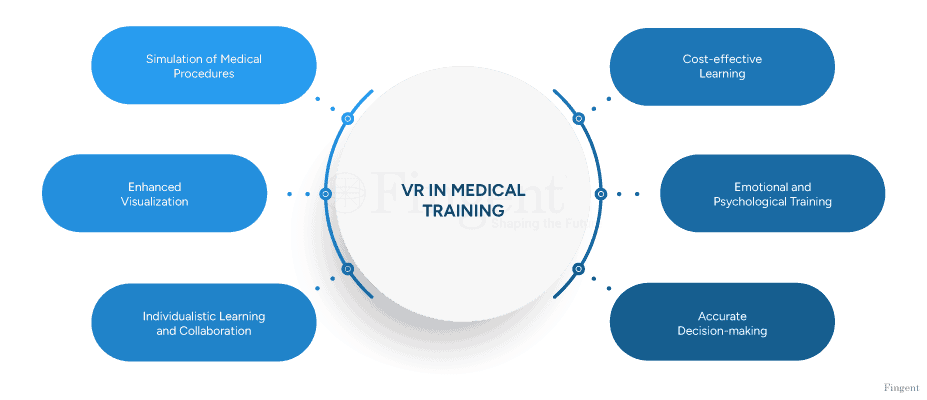VR in Medical Training: Top Benefits and Use Cases
Over the years, the healthcare industry has tremendously evolved. It’s almost like the epitome of technological advancements! In the year 2020, the global medical technology market was valued at $456.9 billion and now is projected to reach $695.5 billion by 2027. From improving healthcare treatments to patient care and diagnosis, healthcare has leveraged every advancing digital capability to enhance itself. Now, the industry is on to transforming its training methods with Virtual Reality (VR). How is VR in medical training promising boosted performance and enhanced medical skills? Is VR turning the future of medical training? Let’s find out in this 3-minute read!
What Are Some Common Medical Training Challenges?
Medical training is critical and imposes challenges that go beyond lecture halls. The sheer volume of healthcare professionals, the need to grasp knowledge within a limited time, and the logistics of it all are challenging, to say the least. It has a direct impact on the quality and effectiveness of future healthcare. Here’s a look at the top roadblocks in medical training that need to be addressed urgently.
1. Balancing Quality With Quantity
Every reputed healthcare organization ensures regular and effective training for all its professionals. However, when the learners are large, it is often challenging to manage the training and provide personalized experiences. Neither can enough equipment be provided to all students nor can training effectiveness be compromised. This dilemma, if not resolved, can lead to underskilled medical professionals.
2. Logistical Constraints
There are many logistical hurdles that healthcare institutes must juggle. These range from coordination of healthcare facilities to scheduling lessons. Preparing interactive lesson plans and prepping room practice are some other logistical challenges. The complexity of these challenges hinders institutions from upscaling their programs.
3. Adapting to Technological Advancements
New advancements are popping up every day in the world of healthcare. Sometimes, adapting to these changes can be challenging. Institutions must constantly update their programs. They must provide healthcare professionals with the most current resources and expertise. Despite new technologies having a positive impact, they can be difficult to install and implement.
4. Forward-thinking Strategies
Grasping complex medical concepts in less time can be challenging. This calls for the implementation of novel strategies and curriculum models. These models should cater to the evolving landscape of healthcare. They should also support the next generation of e-learners. Institutions have to equip themselves to guide the new generation. A generation that will demand a dynamic and immersive learning experience.
How Does VR Advance Traditional Medical Training?

VR in medical training discards traditional learning methods. Creating simulations similar to real-life scenarios equips learners to respond quickly and accurately to emergencies. Also, allowing learners to replay the same situation often helps perfect medical procedures. It builds muscle memory and unparalleled confidence when faced with real-life situations. Here are some ways VR contributes to medical training:
1. Simulation of Medical Procedures
Virtual reality for medical training allows professionals to practice complex procedures in an immersive virtual environment. These situations are replicated with high fidelity, providing a safe learning space. Learners can refine their skills and discover new ways to address problems—all this without risking patient safety.
2. Enhanced Visualization
With VR, students can view complicated medical concepts and anatomical structures in 3D. This enhances their learning experience. It also allows them to explore the human body from various angles and perspectives.
3. Individualistic Learning and Collaboration
VR allows for remote participation. Here, every learner has the opportunity to have hands-on experience. They can collaborate or even learn as a group through VR projections. Learners from different geographical locations can join the same virtual space. Thus helping them learn and practice. VR also allows instructors to supervise learners in real-time. VR training builds teamwork and collective learning.
4. Cost-effective Learning
Setting up and managing VR systems can be cost-effective in the long run. Traditional methods need a lot of facilities that are not friendly to the pocket. Cost-effectiveness can make training more accessible to a wide range of medical students.
5. Emotional and Psychological Training
Virtual reality for medical training can eliminate high-stress situations. It will help students practice under pressure. Traditional settings cannot create these situations accurately. They also help learners practice the management of emotions. It helps them deal with the psychological implications of patient care.
6. Accurate Decision-making
One of the most important skills of a medical professional is accurate decision-making. This ability is not inborn; it is learned through practice. VR scenarios can create ethical dilemmas. This allows trainees to explore different outcomes based on their decisions. This helps sharpen their critical thinking and ethical decision-making skills.
Can VR Supercharge Training and Ease Technology Adoption in Healthcare?
What are the Benefits of VR in Medical Training?
Virtual Reality creates radical stimulating experiences that can be manipulated to practice scenarios or duplicate situations. These simulations can be accessed through virtual headsets and controllers to enable more immersive and engaging training. Headsets equipped with VR glasses and headphones boost these experiences, making them more seamless and effective. Pairing with hand controllers helps duplicate movements that enable trainers to practice surgical procedures or complex medical emergencies.
Read more: How Virtual Reality Improves the Standards of Medical Education and Training
The benefits of adopting VR in medical training are innumerable. Here’s a run-down of a few.
1. Reduced Training Costs
Medical training costs are often difficult to assess. The price of implementing simulating systems varies. Regardless, VR works at a reduced cost with fewer resources. Traditional healthcare training requires the involvement of expensive equipment, such as high-fidelity mannequins. VR eradicates the need for such expensive equipment. Furthermore, VR training can occur anywhere and at any time. This removes the expense of travel and accommodation. VR-based medical training can reduce costs without disturbing the quality of education.
A research paper published in the National Library of Medicine makes a valid point: “The larger initial investment in virtual reality can be spread across a large number of trainees and a longer time period with little additional cost, while each live drill requires additional costs that scale with the number of participants.”
2. Increased Training Efficiency
Learning is best established when it is done at one’s own pace. This applies more to medical training. VR allows trainees to practice at their own pace and use whatever materials they need. The ability to repeat training sessions helps learners perfect their lessons. Repetitive VR simulations can enable learners to refine their skills. This, in turn, builds muscle memory and confidence.
3. Enhanced Learning Experience
Virtual reality is known for its ability to offer an immersive experience. Pairing this with healthcare training can create wonders. It will produce an interactive learning experience that engages many senses. This refines muscle memory and makes it easier to absorb and retain knowledge. Virtual reality bridges the gap between theory and application. It leads to a perfect understanding of complicated medical procedures and concepts.
4. Research
Virtual reality has been a game changer in medical research. With this technology, it is easy to experiment and discover new surgical procedures. Many institutions are using virtual reality to study the brain in detail. A study has found that VR is more effective than traditional MRI scans.
5. VR Scenarios
Repetitive virtual reality simulators allow trainees to make mistakes. It also allows users to learn through repeated practices to perfect their performance. This is generally noted as the central feature of virtual reality in medical training. Traditional methods cannot compete with this benefit. They consume too much space, time, and faculty requirements.
6. Easy to Set Up
The entire virtual reality set-up can be accommodated in a space as small as 2 x 2 meters in under 5 minutes. This simplicity allows other simulation activities to take place in the same center. VR-based training also allows senior faculty to focus on other important tasks while students train. Virtual reality also adds the element of gamification. This makes the entire learning process more fun and autonomous.
VR in Medical Training: Some Interesting Use Cases
Research&Markets, a research firm, noted that the VR market would witness a 22.5 percent compound annual growth rate from 2023–27. Many medical institutions have jumped on the bandwagon already.
1. VR Surgical Training
VR simulations can help create complicated scenarios, giving professionals the right practice to drive surgical efficiency. Here’s a quick display of how VR can promote seamless training simulations. It helps develop the appropriate motor skills required for surgery, creating a realistic environment for the residents to practice. A key advantage of such a system is that it also allows educators to supervise the learner’s actions. They can connect to the VR glasses through a laptop device and offer real-time feedback.
2. Nursing Perfected at Johns Hopkins
Johns Hopkins School of Nursing has implemented virtual reality training at all levels. Professionals use VR-based equipment to learn subjects ranging from surgical procedures to nursing practices. Their areas of focus for training range from resuscitation to post-surgical management. The simple VR set-up consists of an Oculus headset and an Alienware computer. The virtual reality configuration also includes hand controllers, which assist in making cognitive decision-making more effective.
3. Real-time feedback at the University of Northampton
The University of Northampton has taken a giant leap forward. They have installed four sets of VR hardware and a large screen in training rooms. These screens and VR hardware display a physical simulation of a hospital ward. The screen also projects what the students are doing in the virtual space. It provides space for educator feedback and group learning. Learners can also take turns leading the VR scenarios with real-time peer companies. This implementation ensures innovative educational structures. It also builds peer support and teamwork.
4. VR trolleys at the University of Oxford
The University of Oxford uses VR simulation to train residents in John Radcliffe Hospital. Instead of integrating VR in a confined simulation space, the faculty uses mobile VR trolleys to transport equipment. Peer learning is also a primary form of learning here. They have groups of ‘super-users’ who introduce VR systems to new students. Another prime feature is that no faculty is expected to take part unless they choose to review student progress.
How is VR for Medical Training Expected to Revolutionize the Healthcare Industry?
Virtual reality for medical training is expected to transform the healthcare industry through its unmatched training strategies. By creating realistic simulations for students to practice, VR enhances the entire learning process.
Recent research tracked that VR in student schedules for laparoscopic surgery has improved educational outcomes by 74%.
VR creates a safe space for trainees to learn from their mistakes. which in turn hones their skills without costly repercussions. This will improve clinical outcomes and patient safety. VR training also reduces costs associated with traditional methods by eliminating the need for expensive equipment. It allows all students to access specialized training and delivers high-quality education.
Aside from training, VR also assists with innovative research in the medical industry. It enables simulations of diseases, treatments, and clinical trials. Research students can examine diseases and develop cures with a more effective approach. It also removes the risk of actually experimenting on patients. VR enables researchers and scientists to find cures for innumerable diseases.
Virtual reality is ready to revolutionize the medical industry. Advancements in education and research will change the world. Research from the Harvard Business Review attests to this fact. The key finding was that participants trained with Osso VR, a VR training and assessment platform, showed improved performance – 230% better than traditional training methods.
Boost Your Brand Value With VR Powered Medical Training & Healthcare Solutions
How Can Your Organization Strategize VR Powered Medical Training Software?
Organizations that are ready to implement VR in medical training must have a sound strategy in place. Here are a few steps that will ensure successful implementation and seamless adoption.
1. Analyze Training Needs
The first step is to identify specific training needs within the organization. Understand which medical procedures, scenarios, or skills will most benefit from VR simulation. This will involve consulting with medical professionals and stakeholders. Sort priorities in terms of significant impact.
2. Select the Right VR Platform
It is important to choose the right VR platform that aligns with your organization’s goals. You should consider factors like flexibility and compatibility with existing systems. Test whether the selected platform can fabricate diverse medical scenarios. This step will ensure a smooth transition from legacy training methods.
3. Develop High-quality Content
Invest in developing high-quality VR content. This content should meet educational objectives and engage students. VR can make subject matter interesting, but designing that subject matter is in your hands. Collaborate with experts to ensure accuracy in simulations. Your content must allow students to practice skills, make decisions, and receive feedback in real-time.
4. Accessibility and Equity
Ensure that the VR training program you create is accessible to all learners. This should include those with disabilities or diverse learning needs. Address any potential hurdles, such as technical requirements or physical accommodations. This will promote effective training.
5. Track and Check Performance
Watch over your VR system and continuously check its performance. Collect feedback from users to identify areas for improvement and refinement. Use data analytics to assess student progress and skill acquisition.
6. Stay Updated With Technology
When you take a step into the realm of advanced technology, there is no backing out. Embrace its changes and stay up-to-date with its advancements. This will also help you upgrade your system according to medical education trends. Incorporate new features and updates into your VR training strategies. It will help to maintain relevance over time.
How Can Fingent Help?
At Fingent, we believe in enabling businesses to recognize opportunities. We also redefine traditional processes with emerging technologies. We offer simple-to-use and quick-to-implement software solutions. These solutions will empower your organization to think beyond basic digitization. We implement an agile method to create high-quality, reliable, and cost-effective solutions.
Our service comprises three main advantages:
- Results adhering to deadlines: We offer transparent project management with warranty-assured deliverables. We also create well-defined project plans that can handle any unexpected challenges.
- Budget-friendly solutions: With Fingent, there are no last-minute surprises. We provide efficient operations with the best coding practices and 24/7 tech support.
- Advanced technological expertise: Nothing says reliability better than expertise. With Fingent, you will experience easy implementation and best practices. We have top-notch developers who offer the best advice on new-age technologies.
VR in medical training is the future! Call us, and let us show you how we can use our expertise to create impactful VR solutions for your organization.
Stay up to date on what's new

Featured Blogs
Stay up to date on
what's new












